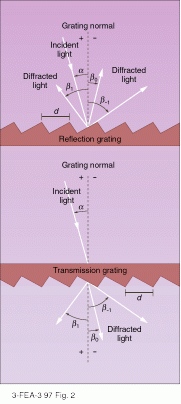

Decorative patterned plastic films based on reflective grating patches are inexpensive and commonplace. Diffraction colors also appear when one looks at a bright point source through a translucent fine-pitch umbrella fabric covering. A usual diffraction grating has parallel lines (It is true for 1-dimensional gratings, but 2 or 3-dimensional gratings are also possible and they have their applications such as wavefront measurement), while a CD has a spiral of finely spaced data tracks. Rainbow-like colors from closely spaced narrow tracks on optical data storage disks such as CDs or DVDs are an example of light diffraction caused by diffraction gratings. Ī diffraction grating can create "rainbow" colors when it is illuminated by a wide-spectrum (e.g., continuous) light source.

Rogers (1804–1882) took over the lead and, by the end of the 19th century, the concave gratings of Henry Augustus Rowland (1848–1901) were the best available. Gratings with the lowest line distance (d) were created, in the 1860s, by Friedrich Adolph Nobert (1806–1881) in Greifswald then the two Americans Lewis Morris Rutherfurd (1816–1892) and William B. Using these principles, Fraunhofer was the first who use a diffraction grating to obtain line spectra and the first who measure the wavelengths of spectral lines with a diffraction grating. The principles of diffraction were discovered by Thomas Young and Augustin-Jean Fresnel. This was similar to notable German physicist Joseph von Fraunhofer's wire diffraction grating in 1821. The first man-made diffraction grating was made around 1785 by Philadelphia inventor David Rittenhouse, who strung hairs between two finely threaded screws. James Gregory (1638–1675) observed the diffraction patterns caused by a bird feather, which was effectively the first diffraction grating (in a natural form) to be discovered, about a year after Isaac Newton's prism experiments. Some gratings modulate the phases of incident waves rather than the amplitude, and these types of gratings can be produced frequently by using holography. Such a grating modulates the amplitude of an incident wave to create a diffraction pattern. įor typical applications, a reflective grating has ridges or rulings on its surface while a transmissive grating has transmissive or hollow slits on its surface. Because of this, diffraction gratings are commonly used in monochromators and spectrometers, but other applications are also possible such as optical encoders for high-precision motion control and wavefront measurement. The grating acts as a dispersive element. The directions or diffraction angles of these beams depend on the wave (light) incident angle to the diffraction grating, the spacing or distance between adjacent diffracting elements (e.g., parallel slits for a transmission grating) on the grating, and the wavelength of the incident light. The emerging coloration is a form of structural coloration. In optics, a diffraction grating is an optical grating with a periodic structure that diffracts light into several beams traveling in different directions (i.e., different diffraction angles). ( December 2011) ( Learn how and when to remove this template message)Ī very large reflecting diffraction grating An incandescent light bulb viewed through a diffractive effects filter. Please help to improve this article by introducing more precise citations. This article includes a list of general references, but it lacks sufficient corresponding inline citations.


 0 kommentar(er)
0 kommentar(er)
